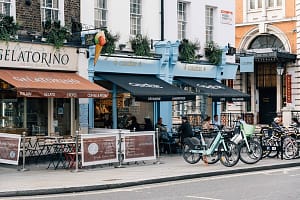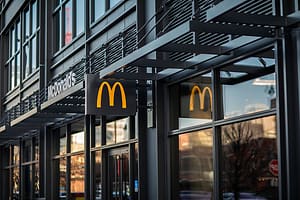Is our male-about-ale Pete Brown right? Tweet us @Londonlovesbiz
A few years ago, in the final months of my career as a freelance strategic planner in advertising, I began to develop a nervous twitch whenever anyone said, “Pop-up”.
You may be surprised to learn that advertising is riddled with clichés. When I first joined back in the early 1990s, you weren’t allowed to say a sentence unless it had the word ‘synergy’ in it. Everyone wanted to ‘do a Haagen Dazs’ in their own product category, which evolved into ‘being the Virgin of’ that category, which begat ‘being the Orange’ of it. Last time I was paying attention, it was a disciplinary matter if any conversation about strategy or branding did not to make at least one reference to Innocent smoothies.
But the concept of a ‘pop up’ has trumped them all. In any meeting about any project, you can set your watch by the inevitability of someone suggesting a pop-up within the first ten minutes: pop-up shops, pop-up restaurants or cafés, pop-up theatres or clubs – for some reason, everyone suddenly decided that doing a temporary version of a thing made it infinitely cooler than launching that thing as a permanent concern. I had to draw the line when someone suggested a ‘pop-up festival’. Festivals by their very nature are temporary. They were pop-ups before people started using this stupid, infantilising term. A pop-up festival would be a pop-up pop-up. But this seemed to have the opposite effect than I wanted, making the marketers absurdly excited about how clever a pop-up pop-up would be.
Once again, I’m happy I don’t work in advertising and marketing any more.
But I’ve been invited to two beery pop-ups in the last month that have convinced me of the validity of the concept – helped enormously be the fact that each was entirely free of people with quiffs and skinny jeans repeating the word ‘pop-up’ and looking enormously pleased with themselves each time they did.
The first was the House of Peroni. I’ve long admired Peroni, even though I don’t often drink it. The beer itself is light on flavour, but in a good way: it’s crisp and clean rather than watery and bland, not that interesting but perfectly fine for what it is. And for the last decade or so, their marketing strategy has been based upon the insight that Italians aren’t known for their brewing prowess (but boy, is that about to change). Italians are known for their expertise in fashion and style. So Peroni is marketed as a fashion brand rather than a beer brand. The House of Peroni website is full of content about style, art and design from an Italian perspective. Again, it’s not really my cup of tea (because for me, it’s always a cup of tea rather than a cappuccino or espresso) but I admire the integrity of the brand, and I’m impressed with how it’s moved into the space vacated by Stella Artois when the Belgian beer decided it could no longer be bothered with premium quality, class and mystique.
Twice a year, the House of Peroni comes to life as a pop- er, temporary physical entity. In May, it celebrated 1963, the year of Peroni Nastro Azzuro’s birth. In October, the theme was Rome, Peroni’s home city. I was invited for lunch about a week before it closed. My only criticism is that I wish I had been invited earlier, so I could have returned several times with friends.
Peroni took over a large town house in Lincoln’s Inn Fields. Each room was given to an artist to execute along a theme of their choosing, inspired by Rome. So there was a room dominated by a silver pillar studded with keyholes. If you peered through a keyhole, you saw scenes of life in Rome. Another room wrapped you in cogs and clockwork, all black and silver and gold. There was creeping paper ivy around the stairwell, and genius lighting effects in rooms where you wanted to hang out and feel urbane.
The bar, obviously, stocked Peroni as the only beer. But it also had an interesting range of Peroni cocktails. No, don’t laugh – beer cocktails are a bad idea if you start with the beer and try to do something interesting to it. If you treat beer as an ingredient just like any other, a good mixologist can make it part of some interesting and wonderful creations. There’s also a restaurant – booked up for the whole month before it even opened apparently – offering a fresh, stylish take on Italian food, and a small cinema.
There’s an awful lot on nonsense talked about ‘experiential’ marketing, about ‘bringing the brand to life’. It’s an ambitious idea that’s easy to get wrong, and when it goes wrong, it can be awful. In the House of Peroni, it worked brilliantly. It’s a simple brief, executed by talented people, with a big enough budget to make it work. It doesn’t feel like it is forcing Peroni down your throat, and it’s stylish enough for you to enjoy without feeling like you’re being marketed to. I’m looking forward to the next one.
My second branded temporary event experience was courtesy of the Camden Town Brewery, which has just devoted an entire week to the launch of a major new beer. Camden makes an amazing lager, Camden Hells, but London is currently in love with hoppy pale ales. So Imperial Hells Lager is a lager with the hop character of an India Pale Ale. Again, it’s an idea that would be utterly dreadful in the wrong hands, but has instead turned out to be your new favourite beer that you just haven’t tried yet.
To celebrate the launch, the brewery took over a space on Royal College Street in Camden, turning it into the temporary ‘Temple of IHL’. While this clearly didn’t have the budget of House of Peroni, it was executed with a similar style and flair, mixed with the appropriate level of grungy attitude. One wall featured figures with animal heads praying to the beer. Another had the Ten Commandments of IHL, including such edicts as ‘Thou shalt not take lager’s name in vain’ and ‘Thou shalt seek new experiences’. There were DJ sets, a festival of canned craft beer, and on the Friday night, a Feast of IHL, a £40-a-head dinner that lived up to its epic billing. The whole thing felt like a festival, like the brewery was truly celebrating the launch of a beer it genuinely felt passionate about.
The Temple of IHL was simpler and freer than the House of Peroni, but as an experience that brought the brand to life and created excitement around it, it was just as successful.
Each event would lose some of its lustre if they attempted to turn it onto a permanent branded bar. Each left me wanting more, hoping the next iteration will be along soon. Grudgingly, I can now see the point of pop-ups. I just ask any marketer considering one to make sure it’s as good as these two.
NOW READ

Coca-Cola could become the new Boris Bikes sponsor. Here are its other most contentious deals
What, no mud? John Nugent reflects on London Film Festival and sitting in silence in the dark

Car-mageddon: Congestion costs London $8.5bn a year and it’s getting worse

The best Christmas party venues in London






Leave a Comment